Dubing Chen
Nanjing University of Science and Technology
Semantic Causality-Aware Vision-Based 3D Occupancy Prediction
Sep 10, 2025Abstract:Vision-based 3D semantic occupancy prediction is a critical task in 3D vision that integrates volumetric 3D reconstruction with semantic understanding. Existing methods, however, often rely on modular pipelines. These modules are typically optimized independently or use pre-configured inputs, leading to cascading errors. In this paper, we address this limitation by designing a novel causal loss that enables holistic, end-to-end supervision of the modular 2D-to-3D transformation pipeline. Grounded in the principle of 2D-to-3D semantic causality, this loss regulates the gradient flow from 3D voxel representations back to the 2D features. Consequently, it renders the entire pipeline differentiable, unifying the learning process and making previously non-trainable components fully learnable. Building on this principle, we propose the Semantic Causality-Aware 2D-to-3D Transformation, which comprises three components guided by our causal loss: Channel-Grouped Lifting for adaptive semantic mapping, Learnable Camera Offsets for enhanced robustness against camera perturbations, and Normalized Convolution for effective feature propagation. Extensive experiments demonstrate that our method achieves state-of-the-art performance on the Occ3D benchmark, demonstrating significant robustness to camera perturbations and improved 2D-to-3D semantic consistency.
Rethinking Temporal Fusion with a Unified Gradient Descent View for 3D Semantic Occupancy Prediction
Apr 18, 2025Abstract:We present GDFusion, a temporal fusion method for vision-based 3D semantic occupancy prediction (VisionOcc). GDFusion opens up the underexplored aspects of temporal fusion within the VisionOcc framework, focusing on both temporal cues and fusion strategies. It systematically examines the entire VisionOcc pipeline, identifying three fundamental yet previously overlooked temporal cues: scene-level consistency, motion calibration, and geometric complementation. These cues capture diverse facets of temporal evolution and make distinct contributions across various modules in the VisionOcc framework. To effectively fuse temporal signals across heterogeneous representations, we propose a novel fusion strategy by reinterpreting the formulation of vanilla RNNs. This reinterpretation leverages gradient descent on features to unify the integration of diverse temporal information, seamlessly embedding the proposed temporal cues into the network. Extensive experiments on nuScenes demonstrate that GDFusion significantly outperforms established baselines. Notably, on Occ3D benchmark, it achieves 1.4\%-4.8\% mIoU improvements and reduces memory consumption by 27\%-72\%.
ALOcc: Adaptive Lifting-based 3D Semantic Occupancy and Cost Volume-based Flow Prediction
Nov 12, 2024Abstract:Vision-based semantic occupancy and flow prediction plays a crucial role in providing spatiotemporal cues for real-world tasks, such as autonomous driving. Existing methods prioritize higher accuracy to cater to the demands of these tasks. In this work, we strive to improve performance by introducing a series of targeted improvements for 3D semantic occupancy prediction and flow estimation. First, we introduce an occlusion-aware adaptive lifting mechanism with a depth denoising technique to improve the robustness of 2D-to-3D feature transformation and reduce the reliance on depth priors. Second, we strengthen the semantic consistency between 3D features and their original 2D modalities by utilizing shared semantic prototypes to jointly constrain both 2D and 3D features. This is complemented by confidence- and category-based sampling strategies to tackle long-tail challenges in 3D space. To alleviate the feature encoding burden in the joint prediction of semantics and flow, we propose a BEV cost volume-based prediction method that links flow and semantic features through a cost volume and employs a classification-regression supervision scheme to address the varying flow scales in dynamic scenes. Our purely convolutional architecture framework, named ALOcc, achieves an optimal tradeoff between speed and accuracy achieving state-of-the-art results on multiple benchmarks. On Occ3D and training without the camera visible mask, our ALOcc achieves an absolute gain of 2.5\% in terms of RayIoU while operating at a comparable speed compared to the state-of-the-art, using the same input size (256$\times$704) and ResNet-50 backbone. Our method also achieves 2nd place in the CVPR24 Occupancy and Flow Prediction Competition.
AdaOcc: Adaptive Forward View Transformation and Flow Modeling for 3D Occupancy and Flow Prediction
Jul 01, 2024



Abstract:In this technical report, we present our solution for the Vision-Centric 3D Occupancy and Flow Prediction track in the nuScenes Open-Occ Dataset Challenge at CVPR 2024. Our innovative approach involves a dual-stage framework that enhances 3D occupancy and flow predictions by incorporating adaptive forward view transformation and flow modeling. Initially, we independently train the occupancy model, followed by flow prediction using sequential frame integration. Our method combines regression with classification to address scale variations in different scenes, and leverages predicted flow to warp current voxel features to future frames, guided by future frame ground truth. Experimental results on the nuScenes dataset demonstrate significant improvements in accuracy and robustness, showcasing the effectiveness of our approach in real-world scenarios. Our single model based on Swin-Base ranks second on the public leaderboard, validating the potential of our method in advancing autonomous car perception systems.
Evolutionary Generalized Zero-Shot Learning
Nov 23, 2022
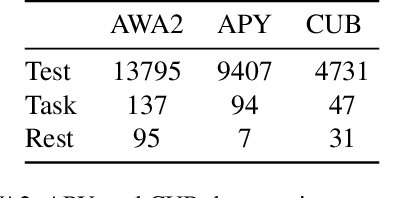
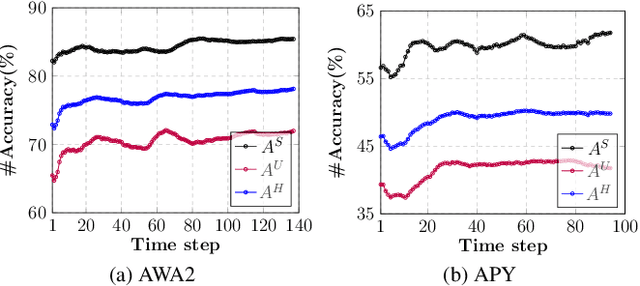

Abstract:An open problem on the path to artificial intelligence is generalization from the known to the unknown, which is instantiated as Generalized Zero-Shot Learning (GZSL) task. In this work, we propose a novel Evolutionary Generalized Zero-Shot Learning setting, which (i) avoids the domain shift problem in inductive GZSL, and (ii) is more in line with the needs of real-world deployments than transductive GZSL. In the proposed setting, a zero-shot model with poor initial performance is able to achieve online evolution during application. We elaborate on three challenges of this special task, i.e., catastrophic forgetting, initial prediction bias, and evolutionary data class bias. Moreover, we propose targeted solutions for each challenge, resulting in a generic method capable of continuing to evolve on a given initial IGZSL model. Experiments on three popular GZSL benchmark datasets show that our model can learn from the test data stream while other baselines fail.
Mutual Balancing in State-Object Components for Compositional Zero-Shot Learning
Nov 19, 2022



Abstract:Compositional Zero-Shot Learning (CZSL) aims to recognize unseen compositions from seen states and objects. The disparity between the manually labeled semantic information and its actual visual features causes a significant imbalance of visual deviation in the distribution of various object classes and state classes, which is ignored by existing methods. To ameliorate these issues, we consider the CZSL task as an unbalanced multi-label classification task and propose a novel method called MUtual balancing in STate-object components (MUST) for CZSL, which provides a balancing inductive bias for the model. In particular, we split the classification of the composition classes into two consecutive processes to analyze the entanglement of the two components to get additional knowledge in advance, which reflects the degree of visual deviation between the two components. We use the knowledge gained to modify the model's training process in order to generate more distinct class borders for classes with significant visual deviations. Extensive experiments demonstrate that our approach significantly outperforms the state-of-the-art on MIT-States, UT-Zappos, and C-GQA when combined with the basic CZSL frameworks, and it can improve various CZSL frameworks. Our codes are available on https://anonymous.4open.science/r/MUST_CGE/.
Weighted Contrastive Hashing
Sep 28, 2022



Abstract:The development of unsupervised hashing is advanced by the recent popular contrastive learning paradigm. However, previous contrastive learning-based works have been hampered by (1) insufficient data similarity mining based on global-only image representations, and (2) the hash code semantic loss caused by the data augmentation. In this paper, we propose a novel method, namely Weighted Contrative Hashing (WCH), to take a step towards solving these two problems. We introduce a novel mutual attention module to alleviate the problem of information asymmetry in network features caused by the missing image structure during contrative augmentation. Furthermore, we explore the fine-grained semantic relations between images, i.e., we divide the images into multiple patches and calculate similarities between patches. The aggregated weighted similarities, which reflect the deep image relations, are distilled to facilitate the hash codes learning with a distillation loss, so as to obtain better retrieval performance. Extensive experiments show that the proposed WCH significantly outperforms existing unsupervised hashing methods on three benchmark datasets.
Zero-Shot Logit Adjustment
May 05, 2022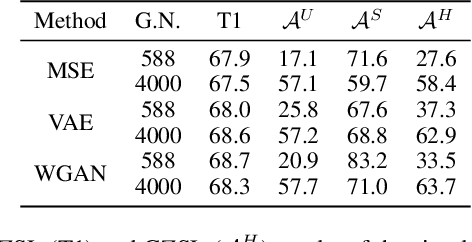
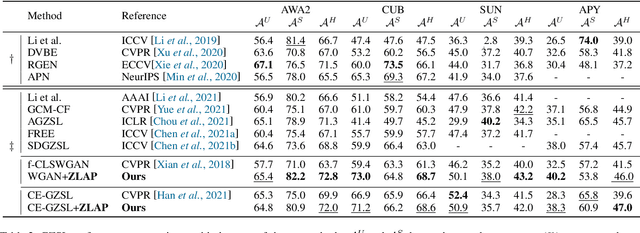
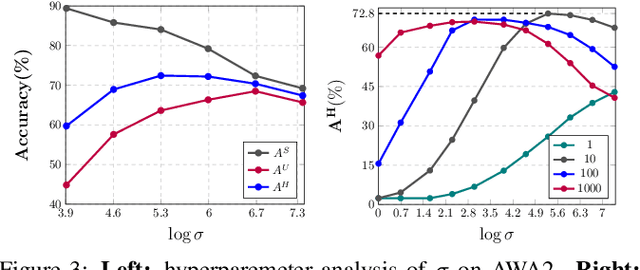
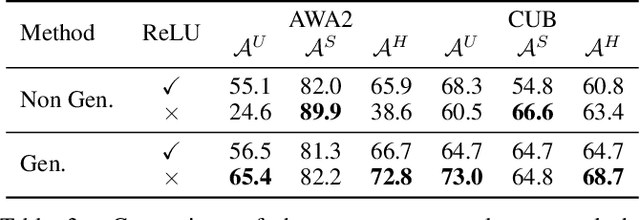
Abstract:Semantic-descriptor-based Generalized Zero-Shot Learning (GZSL) poses challenges in recognizing novel classes in the test phase. The development of generative models enables current GZSL techniques to probe further into the semantic-visual link, culminating in a two-stage form that includes a generator and a classifier. However, existing generation-based methods focus on enhancing the generator's effect while neglecting the improvement of the classifier. In this paper, we first analyze of two properties of the generated pseudo unseen samples: bias and homogeneity. Then, we perform variational Bayesian inference to back-derive the evaluation metrics, which reflects the balance of the seen and unseen classes. As a consequence of our derivation, the aforementioned two properties are incorporated into the classifier training as seen-unseen priors via logit adjustment. The Zero-Shot Logit Adjustment further puts semantic-based classifiers into effect in generation-based GZSL. Our experiments demonstrate that the proposed technique achieves state-of-the-art when combined with the basic generator, and it can improve various generative Zero-Shot Learning frameworks. Our codes are available on https://github.com/cdb342/IJCAI-2022-ZLA.
Towards the Semantic Weak Generalization Problem in Generative Zero-Shot Learning: Ante-hoc and Post-hoc
Apr 24, 2022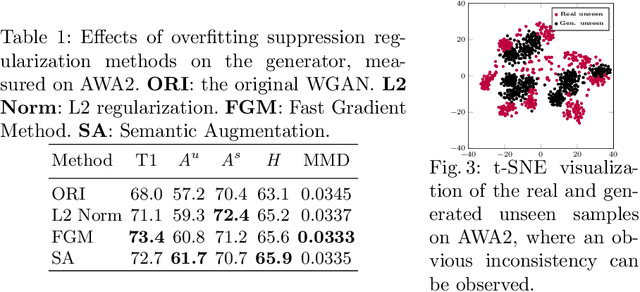
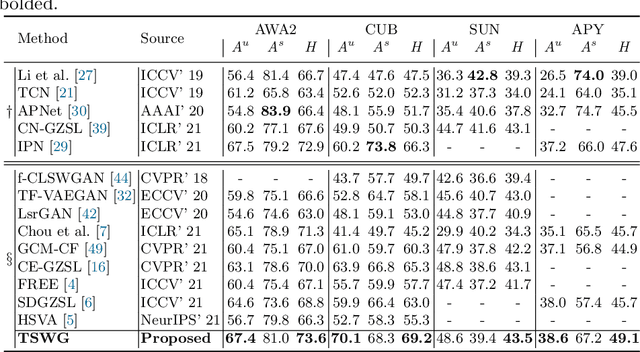


Abstract:In this paper, we present a simple and effective strategy lowering the previously unexplored factors that limit the performance ceiling of generative Zero-Shot Learning (ZSL). We begin by formally defining semantic generalization, then look into approaches for reducing the semantic weak generalization problem and minimizing its negative influence on classifier training. In the ante-hoc phase, we augment the generator's semantic input, as well as relax the fitting target of the generator. In the post-hoc phase (after generating simulated unseen samples), we derive from the gradient of the loss function to minimize the gradient increment on seen classifier weights carried by biased unseen distribution, which tends to cause misleading on intra-seen class decision boundaries. Without complicated designs, our approach hit the essential problem and significantly outperform the state-of-the-art on four widely used ZSL datasets.
 Add to Chrome
Add to Chrome Add to Firefox
Add to Firefox Add to Edge
Add to Edge